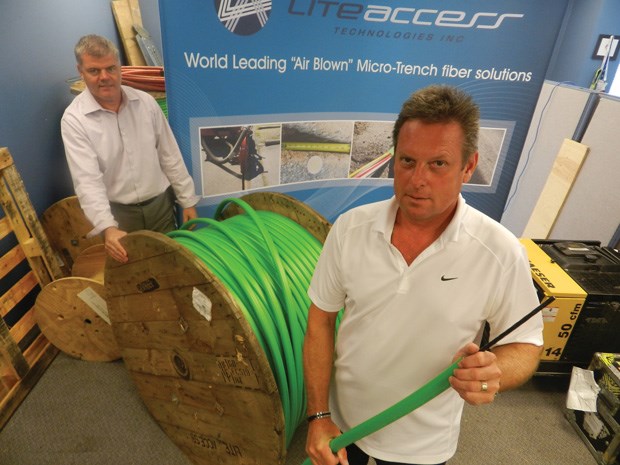Lite Access Technologies Inc. is pioneering a technique to install fibre optic cable using compressed air to blow the fine strands of flexible glass or plastic that are thinner than strands of human hair along great lengths of special ducting that can be embedded in streets and other areas with much less disruption than usual methods.
The process is called micro trenching, and Mike Plotnikoff and Michael Priest have been guiding and refining the process over the last decade.
It consists of pumping air into special tubes inserted into the micro ducts which create a cushion and reduces friction inside. This allows the fibres to float and travel, snag-free, around bends at speeds up to three feet per second.
“As long as you don’t kink a tube, then everything floats perfectly through,” Plotnikoff said. “And it’s all dependent on the route, but ultimately it’s done in a very short time.”
And just how far they can “blow” a cable depends on how much fibre optic cable the manufacturer puts on a on a spool.
“We say we can go unlimited distances. But what does that mean?” Plotnikoff said. “Well, we can blow fibre... (the entire length that)...the fibre has been manufactured. And that’s usually about six kilometres.”
Traditional methods of laying data cable usually involves pulling it along the length of a tube and that is limited by the tensile strength of the cable, said Plotnikoff. That can result in a distance of 500 metres.
But it’s not just the greater distance air-blown fibre can travel which makes the Lite Access method attractive — it’s also easier to install.
That’s because of the micro-trenching process they use is a less invasive and quicker way of cutting into the ground to lay down the cable.
Traditional installations require a back hoe to dig a trench to drop in a two or three-inch diameter pipe through which fibre is pulled.
A Lite Access micro-trench is made using special cutting equipment and is one and a quarter inches wide and 12 to 14 inches deep. And the micro ducts they install into the trench, which are manufactured in Scotland, is a mere inch wide.
“It’s (micro-trench) only placed about 12 inches deep because further down, at 16 and 18 inches, you run into gas lines, sewer and power,” Priest said, adding that can cause slow downs.
“It can cause problems, especially in residential areas. Neighbours get all upset,” Plotnikoff said. “We’re in and out in no time.”
It’s also less expensive, he said, adding they can cut 250 to 500 metres of micro-trench a day at a fraction of traditional methods.
The average cost for traditional trenching one metre is around $750. Lite Access can do it for around $125.
And when it comes to upgrading the cables, which have a 20-year lifespan, blowing replacement fibre along the entire length of an existing duct does away with splicing in new cables, which can lead to degradation of signal, making it less effective.
“The air-blown fibre is the most future-proof method of technology available today,” Plotnikoff said. “We can blow out old fibre and blow in new very quickly. Repairs can also be done very effectively.”
And that’s been a deciding factor for clients that include many overseas, as well as some in Richmond where Lite Access has been involved with some private developments.
Recently, the firm was awarded a contract for the supply and installation of a 9.65 km fibre optic network for the township of Langley.
The network will connect the city’s civic facilities to its operations centre, operations building and the RCMP.
Roughly 60 per cent of Lite Access’ business is done in North America. The remainder includes Asia-Pacific, Central and South America.
“Fibre is the way to go today with the bandwidth limitations with copper (wire),” Plotnikoff said. “With added data uses such as Netflix (streamed movies and TV shows), apps and cellphones, fibre is needed today to support all of those demands. That’s because you can have unlimited amounts of bandwidth pass along a piece of glass compared to a copper cable.”



